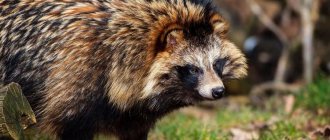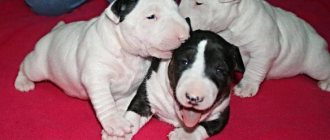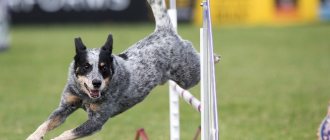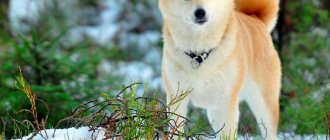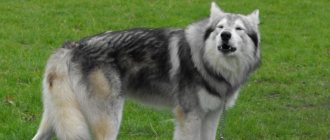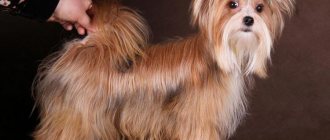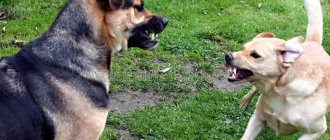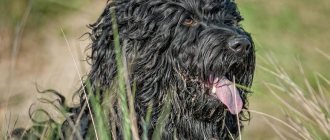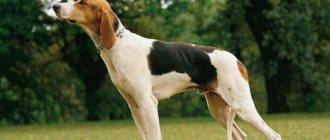Appearance of raccoons and raccoon dogs
Looking at what a raccoon dog and a raccoon look like, the differences are actually quite significant, despite the general similarity of the animals. First of all, it should be understood that they belong to different representatives of the animal world.
Raccoon and raccoon dog
Raccoons belong to the raccoon family, while raccoon dogs are members of the canids. Despite this, most people confuse these animals due to their external similarities. To understand the main difference between a raccoon and a raccoon dog, you should thoroughly study the difference in appearance.
Scull
The structure of the raccoon dog's skull is very similar to that of South American foxes. However, in fact, these animals have very little in common with each other.
For your information! The raccoon dog can be distinguished by its small, slightly elongated skull with narrow cheekbones. With age, the sagittal ridge becomes clearly visible in older individuals. The canines are poorly developed.
Raccoons have a rather short, wide and sharp muzzle, on which small round ears are located. The nasal bones are wide and short. The occipital crest is quite well expressed, while the sagittal crest is weak. The number of teeth reaches 36-42 pieces.
Torso
Raccoon dogs have an elongated torso and short legs. The body length can reach from 45 to 70 cm. The tail reaches a length of up to 12-18 cm. If you compare it with the total body length, the tail of a raccoon dog is relatively short.
The ears are small and clearly visible. Body weight, depending on the season, ranges from 3 to 10 kg.
Note! Representatives of the raccoon family grow up to 40-65 cm in length. At the same time, their tail is much longer, up to 25-27 cm. In most cases, it is quite fluffy. These animals weigh up to 25 kg.
A special feature is the structure of the front paws. Raccoons have sensitive and flexible fingers that allow them to easily grasp objects.
When in an upright position, small predators rely on the entire sole of their limbs, and when walking only on their toes.
Wool
By winter, the fur of members of the canine family becomes longer, thicker and coarser. It can reach 12 cm in length. Such fur can protect the animal even in the most severe frosts.
The coat color is dirty brown or gray-brown, the guard hairs are black. The tail has a darker color. The fur on the belly is yellowish in color, and the chest is darker. The hairs on the face are short and increase in length behind the eyes.
On a note! In summer, the fur becomes shorter and acquires a brighter red-yellow hue.
Raccoons have fur that varies depending on the species. So, for example, in the crustacean it is shorter, while in the gargle and kosemel it is long and thick. The color of different representatives is the same. The animals have gray-brown hair on the body and a tail with black and white stripes.
In the wild, raccoons behave differently than they do at home.
Main differences
The most important difference between a raccoon and a raccoon dog is that they belong to different species. The first belongs to the raccoon family, the second to the canids. At the same time, the animals are surprisingly similar in appearance and in some aspects of behavior, for example, in winter they hibernate.
When carefully comparing the two animals, the differences are clearly visible. A raccoon's fur is fluffier and softer, while a dog's fur is long, coarse, and very dense. Raccoon paws resemble human hands: they are equipped with tenacious fingers without tufts of hair between them. Such limbs allow the animal to climb trees, run fast and swim well. The dog's paws are the same as those of all canines.
In the wild, the sharpest raccoon is most easily identified by the stripes on its tail. In an adult animal, dark and light rings are clearly visible on the fur; the raccoon's tail is monochromatic. A dog's coat usually has a warmer, sandy hue; raccoons have a predominant cool brownish-gray color.
Raccoons and dogs in nature: where they live, what they eat
The habitat of representatives of the canine family is the forests of the Middle Zone or the north. They are also called raccoon, Ussuri dog or Ussuri fox. In terms of choosing housing, they are quite unpretentious; they can evict badgers or foxes from their holes and take their place.
For your information! Often these animals arrange their beds between the roots of trees or even settle next to roads or near villages.
The Ussuri fox can climb trees, but not too high. In other words, they resort to lasagna when absolutely necessary. Raccoon dogs are nocturnal animals. Most often they are engaged in gathering. The diet of the Ussuri fox includes:
- chicks or eggs;
- lizards, mice, frogs;
- insects or larvae.
Before winter, to maintain their mass, animals begin to collect and eat fallen tree fruits, seeds or berries. If a populated area is close, raccoon dogs can visit a person without fear.
Note! This representative of the canine family hibernates during the winter. The animal is able to sleep from December to March with short breaks during the thaw period. If the winter is warm enough, the Ussuri fox does not fall asleep, but leads a measured lifestyle, hibernating only during the period of severe frosts.
The Ussuri dog is a fairly agile and strong animal. Nevertheless, she has a kind and sociable disposition, although she is a little cowardly. On the other hand, the character completely changes during the period of feeding the offspring. The female becomes aggressive and nervous. In this state, she is capable of severely biting any uninvited guest.
Raccoons live in southern Canada. They can be found in greater numbers in North and Central America. Coniferous or mixed forests are chosen for housing. Moreover, there must be bodies of water near their houses.
Important! Despite the fact that these are wild predators, they can perfectly make their homes next to humans and even in the attic of an old house.
Raccoons are mostly carnivores, but they can eat almost anything. In the spring, they hunt small rodents and birds. In autumn, they prefer plant foods. They also don’t forget about the contents of garbage cans.
Despite the fact that these animals are loners, they are quite friendly and are happy to make contact. They do not show any aggression even towards their natural neighbors.
These animals are not picky when choosing housing.
Conditions and care
In order for the animal to feel good, it needs to be walked just like a domestic dog.
Having an enclosure on the balcony does not eliminate the need to provide the animal with physical exercise and an emotionally rich life.
An apartment where a raccoon dog lives very quickly acquires a bouquet of aromas that are not typical for a human home. The animal itself has almost no smell, but its excrement smells very pungent and unpleasant.
In addition, they like to mark their home, which can turn a person’s home into a raccoon hole.
The only way to avoid marks is early castration.
Caring for this animal is in many ways similar to caring for a domestic dog. The only exception is the impossibility of walking with such a dog in crowded places.
If there is a fenced area, she can be let out for a walk with the dogs.
The raccoon is usually good friends with them if there is no aggression on their part. Friendship is possible even with cats. But birds and rodents can be considered food by it.
Enclosures for raccoon pets are made approximately the same as for small breeds of domestic dogs. In conditions of satiety and well-being, the animal does not hibernate, but pleases its owners with an active life.
What does a raccoon dog eat? Her diet consists of:
- mouse-like rodents;
- birds and their eggs;
- amphibians;
- insects;
- worms;
- berries;
- fruits;
- grain plants.
As befits representatives of the canine family, these dogs do not disdain carrion and food waste.
There are no problems with feeding for such pets. They can be fed like dogs. , and it’s best to cook porridge with meat and fish for them. Raw meat and raw sea fish should be given periodically.
All vitamin and mineral supplements for dogs are quite suitable for their raccoon counterparts.
A raccoon dog lives up to 15 years at home, and no more than 5 years in the wild.
Is domestication possible?
As you can understand, the character of the raccoon and the Ussuri fox has significant differences. Because of this, the learning process will be completely different. Adult raccoons are tamed gradually, but due to their natural sociability, this process cannot be called difficult.
On the other hand, Ussuri foxes become quite suspicious as adults and do not make good contact with people. When they see a person, these animals prefer to run and hide.
Babies of both families can be tamed quite easily. Raised in captivity, they are affectionate, sociable and easily live with humans.
Domestication of these animals is quite possible, but you need to start training them in puppyhood
Thus, the differences and similarities between the raccoon and the raccoon dog are very significant. Despite the fact that these animals are different species, they have many common features, which is why people often confuse them. The main thing is to just take a closer look at them.
Character
Raccoon dogs are loyal, affectionate, moderately playful, intelligent and not mischievous, but very careful, and can even be cowardly in their behavior. They are very capricious and have their own opinion on everything. Raccoons are trainable and can remember several commands. The character and degree of tameness depends on both the owner and the puppy itself, but even a baby fed and raised from scratch will not become an absolutely domestic animal.
In February-March, during the rut, even very cute and tame creatures can be nervous and aggressive.
Optimal living conditions are in a private home. Some people bring animals into the apartment and set up an enclosure on the balcony, but in this case they will have to provide good walking and take into account several negative aspects.
The raccoon dog itself has no odor, or rather has a specific sweetish aroma, and its feces smell quite sharp and unpleasant.
Even if the dog goes to the litter box, its presence in the house is felt. Both females and males mark their territory; their marks have an even more pungent odor. Only early castration/sterilization will help get rid of the problem. Accessories and enclosures are the same as for small breed dogs. A raccoon dog is relatively inexpensive, and the cost of keeping it is about the same as an average dog. At home, the animal does not hibernate, but may not leave the booth in severe frosts.
It is difficult to say anything in advance about cohabitation with other animals. They often get along well with dogs and play together. Relationships with cats are worse, and small rodents and birds will most likely be regarded by the animal as potential prey.
Caring for a raccoon dog is not difficult. It is advisable to comb the coat during the molting period to speed up hair change and maintain a neat appearance. In nature, dogs rub against branches and roots to get rid of excess hair. Bathed infrequently, as needed.
Video about keeping raccoon dogs:
What do a raccoon and a raccoon dog have in common?
Raccoons and raccoon dogs are completely different species of animals. If raccoons belong to the raccoon family, then raccoon dogs are members of the canids. But still. Even despite the difference in the genetic component, a raccoon dog can be confused with a striped raccoon. Before we talk about how a raccoon differs from a raccoon dog, let's talk about the similarities of these wonderful animals.
- The raccoon dog has a typical raccoon mask and light whiskers on its face.
- Raccoon dogs are slightly larger than raccoon dogs, but the overall proportions of the head, body, tail and paws are approximately the same as those of striped raccoons.
- The fur of raccoon dogs resembles that of a raccoon. Let me make a note about the difference between a raccoon and a dog. Raccoon dogs have a solid tail, that is, without the striped color, like raccoons.
Related material: How smart are raccoons?
In addition to physiological similarities, raccoon dogs are similar to raccoons in their habits.
- The raccoon dog leads a twilight-nocturnal lifestyle.
- Just like raccoons, raccoon dogs can settle near roads and near populated areas.
- Raccoon dogs hibernate. This is the only canine that can hibernate. If the winter is warm, then raccoon dogs are awake.
- Raccoon and raccoon dogs are omnivores.
- Raccoons and raccoon dogs have common enemies: wolves, lynxes and jackals.
Now we can touch on the topic of how a raccoon dog differs from a striped raccoon?
Main differences
The most important difference between a raccoon and a raccoon dog is that they belong to different species. The first belongs to the raccoon family, the second to the canids. At the same time, the animals are surprisingly similar in appearance and in some aspects of behavior, for example, in winter they hibernate.
When carefully comparing the two animals, the differences are clearly visible. A raccoon's fur is fluffier and softer, while a dog's fur is long, coarse, and very dense. Raccoon paws resemble human hands: they are equipped with tenacious fingers without tufts of hair between them. Such limbs allow the animal to climb trees, run fast and swim well. The dog's paws are the same as those of all canines.
In the wild, the sharpest raccoon is most easily identified by the stripes on its tail. In an adult animal, dark and light rings are clearly visible on the fur; the raccoon's tail is monochromatic. A dog's coat usually has a warmer, sandy hue; raccoons have a predominant cool brownish-gray color.
Any zoologist can accurately answer the question of how a raccoon differs from a raccoon dog. After studying some of the features of these animals, the difference becomes obvious to ordinary people. Raccoons: characteristics and appearance A raccoon is a predatory animal, a representative of the family of the same name. Several species are found in the wild, the striper living in America and Eurasia is especially common. The animal is small, average [...]
Differences between raccoon dogs and raccoons
- Raccoon raccoons have developed paws that resemble human palms. Raccoon dogs have ordinary paws, like all dogs.
- Raccoon dogs cannot climb trees.
- Raccoons love to hunt, while raccoon dogs focus on gathering.
- Raccoon dogs live in pairs, while raccoons (especially males) prefer to lead a solitary lifestyle.
Pay attention to the article about the types of raccoons, similarities and differences between raccoons.
Of course, this is not all that differs between a raccoon dog and a striped raccoon. The difference between these animals lies in the level of energy potential. Raccoons undoubtedly operate at a higher energy level. They are more mobile, agile, quick-witted and efficient.
Regarding the geography of distribution, raccoon dogs are found only in Eurasia. Raccoon dogs are most widespread in the northeastern part of the continent. In some European countries, the population of raccoon dogs is being artificially exterminated.
In Sweden, a total hunt for the raccoon dog has been open since 2013. The fact is that raccoon dogs were artificially introduced by USSR scientists into European countries. Representatives of the ruling elite do not like this moment at all.
This is the main difference between the striped raccoon and the raccoon dog.
Nutrition
Raccoon dogs are omnivores, feeding on insects, rodents, amphibians, birds, fish, reptiles, shellfish, carrion and insectivores. Among rodents, raccoon dogs usually prey on voles, but gerbils are also suitable. Frogs are the most commonly eaten amphibian; in the Voronezh region, raccoons often eat toads, while spade toads are caught by individuals living in Ukraine. Raccoon dogs are able to eat toads that secrete toxic mucus: they produce enough saliva to dilute the toxins. Raccoons also prey on waterfowl, passerines and migratory birds. Pheasants and partridges are also on the list of their prey. Raccoon dogs also eat fish that swim near the shore. They rarely catch it during spawning, but the real feast begins during the spring melting of the snow. Some raccoons feed on young turtles and their eggs. The insectivorous mammals that raccoon dogs hunt are often hedgehogs and shrews. The plant portion of their diet may include oat bulbs and rhizomes, millet, corn, nuts, fruits, berries, grapes, melons, watermelons, pumpkins and tomatoes.
Raccoon dogs change the composition of their food depending on the season: in late autumn and winter they feed mainly on rodents and carrion, while fruits, insects and amphibians predominate in the spring. In the summer they eat fewer rodents, mainly targeting nesting birds and fruits, grains and vegetables.
Japanese raccoon dog
Young raccoon dog
Raccoon dog is my wild pet, kept in an apartment
Roxana is 7 months old. For those who are planning to get this wonderful animal. I will constantly add to and make changes. Raccoon dogs, although they are members of the canine family, are more similar in behavioral habits to foxes, and externally resemble raccoons. We went through everything ourselves from our own experience, there is little information, practically no one keeps them in the apartment, but only in an enclosure. I will reveal all the delights and difficulties of raising and keeping a raccoon-tanuki in an apartment on a free run like a domestic dog. Have questions? Write, I’ll share my experience, I’ll tell you what I know. I can immediately assure conservationists that I also believe that a wild animal should live in the forest and under no circumstances should it be taken from the forest. Our animal, domestically bred, that is, grandparents (several generations), parents - all lived in captivity, so it simply cannot survive in the forest, because its parents did not teach it anything, neither to be afraid of people, nor to avoid traps, neither hunt, and in the forest such an animal will simply become easy prey for either a predator or a person. Communicating with such an animal, I understood. that there is no need to re-educate him. you need to adapt to it, you need to be more tolerant and be able to sacrifice, and then everything will work out for you. (continued after photo)
Roxana - our beauty Roxana appeared spontaneously, but it’s good that it was a raccoon dog and not a fox.
My son wanted to get a fox and we chose a fox cub, agreed with the breeder on the price, and when we were about to go for the fox cub, the breeder at the last moment raised the price. Therefore, I had to refuse the purchase. Whatever God does not do is all for the better. I saw an ad for raccoon dog puppies for sale, and we decided to buy a puppy. After reading the literature, the truth is what they could find on the Internet, but there is very little of it, relying on their experience of keeping dogs of different breeds, they chose a girl. We took our Roxanochka at the age of 3 weeks, a tiny cutie who fit in the palm of her hand, and our everyday life began. Anyone who says that raccoon dogs stink is completely wrong. At the age of 3 weeks. puppy smell, like a puppy of an ordinary dog, at the age of 1, 1.5 months. this smell disappears and the puppy smells its sweetish smell. Smells are a separate topic and will be discussed later. Our mistake When we took it, there was no information anywhere at all. They were written either by the breeders who keep them in enclosures, or by hunters. We also thought that she would live on the loggia in a booth and that we would let her run around in the apartment, but we made a mistake; as a little girl she slept next to me, but she should have slept alone on the loggia. Now I can already give some advice to avoid the mistakes that we made. She goes out onto the loggia, but only for a walk of about 5 minutes, and then only if I’m nearby. The truth is now understood. that when she goes out the door is not closed tightly and you can enter home by pushing it, but before I was afraid. You close the door a little and she runs into the apartment. In general, let's explore the world together. But it’s easier with her than with a dog. if not for the night games. But it can be retrained. if you work with her during the day. then at night she will sleep. And I'm at work all day. that's why she's sleeping. But she is smart. Feeding In the meantime, our girl is just a baby, night feedings began every 2 hours. The breeder fed the puppies pedigree for puppies and recommended it to us; after trying to feed it this way, it became clear that the baby was not eating enough, since she was still chewing poorly. We noticed a peculiarity in her (she would fill her mouth full of food, run to the side, spit it all out and start eating) and at first they did not understand what this meant, but then they realized that there were many puppies in the litter and the smartest and most agile one survived, and so there was just food wouldn't be enough. They began to feed me milk porridge - semolina, rice - baby food. Then they started feeding vegetables and meat. Now she eats eggs, cottage cheese, fish, meat, a little cereal in her diet, she loves cheese, apples, bananas, milk porridge made from cereal, and she also has a sweet tooth, she can beg for a piece of chocolate or a lollipop and then she will spend a long time procrastinating, very loves hematogen, we give her a small piece. We gradually increased the intervals between feedings, she ate only at night, slept almost all the time during the day, we did not disturb her, and let the baby grow. Now we feed Roxana once a day. I come home from work at 7 p.m., set two bowls for her to choose from, what she wants to eat first, then she eats it. In one bowl there is milk porridge, which she eats almost all of, in the second bowl there is meat porridge (more meat, liver) and always cheese, which is eaten first. began to add large bones to the diet. Be sure to take vitamins for bones, wool and fish oil, which she loves. And we also give her bones, but not tubular ones, chicken necks, heads, which we pre-cook. Place At first she slept on a heating pad in a large cage in a fur coat. Since I played the role of mother, frequent “licking” of the tummy with a cotton swab dipped in boiled water and wiping the eyes with a swab dipped in strong tea were mandatory. At 1, 1.5 months. She no longer wanted to sit in the cage, and we began to determine her place. Since I was the main caregiver, the place was determined in my room, next to my bed, and a tray was placed in the corner of the room. By two months, Roxana had already decided on a place for herself, in my wardrobe on the bottom shelf, we decided, let it be so. The animal is nocturnal and sleeps during the day, the little one slept almost all the time, and at night we played and ate. I didn't get enough sleep. When Roxana grew up, she decided for herself that she needed another place, and she determined that the library would be hers. At 2.5 months she moved to the library, while she was little she simply slept under the sofa, at three months this became problematic, and at 3.5 she no longer fit under the sofa. She assigned herself a place on the bottom bookshelf (she had to remove the books from the bottom shelves, move the sofa away from the wall and move it closer to the shelf, thus blocking part of the shelf, and she ended up with a kind of hole with a long entrance. Right now there is her den, although the shelf had to increase in width, otherwise her legs were already hanging from the shelf and it seemed to me that she was uncomfortable lying like that. But from time to time she thinks that in the wardrobe I have a lot of shelves with my clothes and constantly vacates the middle two for herself, that is, she throws my things on the floor , and she climbs in there, lies down and goes back to her library. Who is she more a dog or a cat? She walks in the litter box like a cat, she can’t jump high like a dog with short legs, but she perfectly calculates the chains (if she wants to climb onto the windowsill - the bottom shelf in the table, a chair standing nearby, a table and a window sill), can jump on a stool or chair. She walks on a leash like a dog, she loves to swim. How we determined that she loves water. When I told the breeder how Roxana loves to swim, she was surprised ., of course, because her animals live in enclosures. At the age of 1.5 months, when Roxana was already moving freely around the apartment, we began placing a bowl of water on the floor for her. We noticed this peculiarity: our girl tried to put both paws into a bowl of water and began to flop around in the water, eventually turning the bowl over (my son even doubted whether we had a rinse). We decided to give her a pool, fortunately there was a large plastic tray in the cage, and we saw that Roxanna really loves to swim, especially with toys (if I can add a video). In nature, raccoon dogs live along the banks of rivers and swamps and swim very well. I saw a video where a raccoon dog jumped into the water from a bridge and swam calmly. Now after walking we have no problems washing our feet. Roxana herself enters the pool, plops down in it, thereby washing her feet, goes out onto the towel that we lay next to the pool, thereby drying her feet. We change the water to clean. The pool of water is always there and she swims whenever she wants.
Roxana - playing in her pool Tray training. Noticing that the puppy went to the toilet in the opposite corner of the cage from his bed, we put an absorbent diaper there and the problems with the toilet disappeared. Raccoons are very clean and go to the toilet in one place, then, when Roxana was 1.5 months old. and she had her own place outside the cage, the diaper migrated to the cat's litter box, where Roxana began to go to the toilet. Speaking of cleanliness, now Roxana goes outside to the toilet, and also only in one place. Human waste does have a strong odor, but if the tray is removed immediately, there will be no smell in the apartment. As Roxana grew, she began to explore the territory and mark it (nothing can be done, the animal is wild and her instincts are strong), so the trays were in my room, in the library and in my son’s room, the farthest from her place where she slept. But she only went to the litter box, first for diapers. then to the newspaper, which improved our financial condition (these diapers are really expensive), smart girl, she understood everything herself. Now at the age of 7 months. We no longer use litter trays (although there is one in the hallway, just in case), we go to the toilet outside. The weather is cold now and Roxana refused to go outside because her paws are cold, noticing that she was showing interest in Timosha’s tray (this is our cat), which is in the toilet, we put her tray next to it, now we have all the trays in one place, the only inconvenience is that the door is always open, but what can you do, you have to sacrifice something. Pros and cons of keeping a raccoon dog (Ussuri raccoon) Plus - unlike a fox, raccoon and domestic dog, when she is happy and not bored, the raccoon dog does not squeak, does not whine, does not make any sounds, that is, at home she is silent, even plays and having fun in silence. Although she growls very menacingly at strange animals and people, and when she is bored and asks to be played with, she makes a drawn-out sound. In Japan, because of this sound, a tanuki - a raccoon dog - is called a dog - a bird. Another plus is that it doesn’t smell at all, even wet fur doesn’t smell like a dog, like dogs do (and she bathes with us so much that when she comes out of her pool she shakes herself off like a dog, sometimes she just lies in the water). Smells have both pros and cons. On the street I will definitely roll around in odorous excrement if you don’t have time to suppress this desire, so you need to be on your guard while walking. At home she loves the smells of perfume, but not all of them (she loves Chanel, Armani Code), I specially spray it on the carpet or a cotton pad and then she takes her soul away, rubs herself with all parts of her body (and then she smells of Chanel or other perfumes). One of the disadvantages of the content is a weak nervous system, if suddenly some noise runs to hide, and only then comes out to figure out what it was. And out of fear, she releases an unpleasant odor from the violet glands (reminiscent of a strong fishy odor). But now she is no longer panting with fear. If, when she was little, she panted very often and we wanted to remove these glands a year ago, but now we changed our minds, since she no longer pant as before, especially since the veterinarian who sees Roxanochka said that this operation is complicated and is done only per year. Now she has become calmer and is not frightened as before at every occasion. The raccoon dog is a nocturnal animal, and during the day it sleeps in its den. On weekends, when I'm home, she alternates between sleeping and being awake during the day. That is, he has time to play and sleep during the day. If you work with a raccoon dog during the day, it will switch from night mode to day mode and will adapt to you if it is interesting for it to spend time with you. Now that she has grown up, we play catch up with her, she runs away, and she runs very funny, and I catch up with her, like I can’t catch up with the words - I’ll catch up, I’ll catch up, she runs away, her tail is raised up at an angle of 90 degrees, and the muzzle is cunning and content. So cute. In the end, I catch her, she gives in on her own, and I squeeze her. She also has a lot of different toys that she enjoys playing with. Children's problems: First problem While our girl is growing up, we are learning the basics of raising a raccoon dog puppy. The puppy always scratched slightly and we didn’t pay much attention to it, although we washed the child in flea shampoo. At 1.5 months. our girl began to itch terribly, she itches and cries, what should we do, we were terribly scared. We started looking for an experienced exotics doctor; you can make an appointment with such doctors on certain days, and not every day. We found a clinic, made an appointment, 3 days ahead, the child itches, cries, washed it in flea shampoo - it doesn’t help, we search the Internet, the son calls other clinics trying to get an oral consultation. And with our joint efforts we determined the cause of this “scabies.” The puppy began to grow guard hair, just like in a person, when the hair grows, the body itches. They gave me half a quarter of a loratodine tablet for allergies, it also relieves itching, the problem was solved. We breathed a sigh of relief. Problem two: Roxanka had normal stools once, and loose stools the second time; the alarm was sounded - why, what should I do? Again we call “our” clinic, where they know Roxana, and make an appointment with a doctor. We receive oral advice to change food and switch to expensive Proplan food. At the same time, I consult with the breeder, no one can really tell me anything, my head is spinning. But the reason turned out to be simple and we found out again ourselves - we simply overfed her. She grew up and began to regulate how much she should eat at a time. Otherwise, it seemed to me that the baby was malnourished and gave her tastier pieces. Problem three - hiccups Our girl started having hiccups at the age of 2 months. very often, I had to get up at night and give her some water to drink, but the problem had to be solved. And again in a circle. On the zooforum they advised to poison the worms, which we did, but the hiccups did not go away. And again it turned out that the problem was overfeeding. We exhaled when the child grew up. Does she chew furniture? She hasn’t damaged any of our furniture or shoes; she’s not even interested in the wires in her son’s room. All her soft toys are intact, the only thing is that she bites off the plastic noses. Now, if he sees a piece of wallpaper that has come unstuck, he won’t pass by, he’ll definitely be drawn to it, apparently he likes the process and the sound, and for some reason he tears the rags. She has her own bath towels to dry her feet after bathing, so they have holes in them, bitten through. And her weakness is all kinds of plastic drop bottles, she chews them and bathes with them. The only thing she chewed on from the furniture was the liner in the shelf in her den (which we inserted to increase the width of the shelf), but that's okay, the liner can always be replaced. In her den she knows better how to do it, and the leather-covered stool was also damaged - she chewed the leather. Ability to learn She is our pet and we do not place demands on her as a service dog. She knows the “fu” command well, her nickname, the word for a walk, let’s go (when she stops and looks around, I urge her on). Understands phrases like will you have cheese? (he loves cheese very much, he comes running right away), knows the command “run” (if we are walking freely with stops, then just across the road - run), knows the command - “come in” (in the elevator), stand (in the elevator), get out, my legs (she goes into the pool herself after every walk), knows the phrase - I’ll take you in my arms. So communicating with her is not difficult. But again, we have very close contact with her. I don’t think that captive animals know so many words and commands. Vaccinations Vaccinations are the same as for dogs according to age. Before each vaccination, the worms were treated. Incident during a walk Roxana is now 8 months old. Today, on a walk, she grabbed a dead rat and ran, fortunately she was on a leash, I didn’t even immediately understand what was in her teeth since it was 12 o’clock at night, dark. I quickly shouted “fu”, “fu” and she spat out the rat, I didn’t have to take it with my hands, but all sorts of thoughts came into my head, at least nothing happened to Roxanka. Not only that, when we were returning from a walk, she wanted to come back for this rat. She needs an eye and an eye. Now we will monitor the condition.
Roxana on a walk
I found a hole and decided to take a break
on a walk in the forest Video Delete The rut is ahead of us, which we are waiting for and are afraid of. that we don’t know what will happen. So we survived our first rut. Roxana is now 11 months old. We were afraid that we wouldn’t cope, but it’s possible that this is the first rut, and there are no similar animals in the area, we survived it calmly. Yes, we walked a lot, and went where she wanted and she walked guided by her instincts, but there was no male, although we marked all the bins in the area, all the bushes. During the walk we had to deceive her, she walked only in front and didn’t want to return home, then we had to change the route gradually turning her towards the house. sometimes I had to carry her in my arms. Night walks at 12 o'clock at night were short, and at 4 o'clock in the morning longer walks lasted about 30-40 minutes. He really doesn’t like to walk in the snow in winter; his paws get cold, only on his hands and a little on the asphalt. In winter, Roxana did not hibernate, although her appetite was less than usual; there were days when she did not leave her den, she was sleepy and lethargic. It's spring now and Roxana is shedding, this is definitely a problem. There is so much fluff that you can knit more than one scarf or socks. You have to constantly brush it out. So our beauty has grown up. She turned one year old on May 5th. Miracle. not a child. She goes to the toilet both outside and in the litter box with the cat, after a walk she washes her feet in her pool, although then the water needs to be changed, but these are minor things. He sleeps all night, during the day he also takes a nap from about 1 pm to 5 pm, then plays, walks, and swims. It’s true that he’s mischievous over little things (he’ll chew off his son’s rubber band from his phone, or he’ll gnaw on his son’s sneakers, and so, it’s a miracle and not a child. And most importantly, he’s silent, doesn’t whine, doesn’t howl, doesn’t yap, growls only at strangers. In the apartment he prefers to hide in his own den, when strangers come in. When we took her, we already had a cat and little Roxanna apparently thought that she was the same, now she repeats everything after the cat, she goes to the window and Roxana follows her and when she can’t jump like a cat , then she’s very surprised why she can’t do it, but she calculates the chains and very quickly finds an option to be next to the cat on the windowsill. Of course, if we lived in a village or in a country house, where we could make an enclosure for her, it would be possible at all wonderful. But what we have, we have. My opinion is that this is the most problem-free wild animal for keeping at home, of course, if you take it like us at the age of 3 weeks. And another minus is that he is very scared of strangers on a walk when they approach us and wonder what kind of animal it is. Now the time has come to get vaccinated against rabies, leptospirosis, we will accustom him to the hospital, to the smells, and then to the vaccination. Continuation and More videos and photos in the article Raccoon dog. Roxana is my wild love,
In the photo, the raccoon dog looks like a striped raccoon. She has a gray-brown, often dark, color and the same dark mask on her face with pronounced sideburns, which are almost invisible in a raccoon. A longitudinal stripe is noticeable on the back.
Raccoon dog - photo
However, the raccoon dog's closest relatives are foxes and wolves. The raccoon dog lives in holes that it digs itself or occupies abandoned badger “chambers.”
Raccoon dog
In the North Caucasus and Kuban, the raccoon dog settled in forests and steppe regions, not far from reservoirs, in the Azov floodplains. The raccoon dog eats everything it can get: small rodents, insects, shellfish, birds, fish, fruits and even acorns.
By winter, raccoons and raccoon dogs double their weight! Of course, in cold winters, raccoon dogs, like raccoons, hibernate. In the spring, raccoon dogs give birth to up to six blind puppies; both parents take care of the babies, who grow up very quickly.
Raccoon and raccoon dog difference
On the left is a photo of a raccoon dog, on the right is a striped raccoon.
In nature, not in photos, it is not difficult to distinguish a raccoon and a raccoon dog. It is much smaller in size, the height of a cat and about the same length and weight. The coat of the striped raccoon, unlike that of a raccoon dog, is smooth, short, and does not stick out in tufts like that of a raccoon dog. The raccoon dog is the size of an average dog, the body is usually dense, knitted, sometimes elongated.
Raccoon gargle
The photo clearly shows that a raccoon and a raccoon dog have completely different paw structures. The raccoon's are shorter and have developed claws, more reminiscent of human fingers than of animals. Thanks to this structure of the paws, a raccoon can use them to pick up objects, food, sort through and wash food, which looks very funny.
Raccoon dog
The photo also clearly shows the difference in color between a raccoon and a raccoon dog. The raccoon's fur is brownish-gray, while the raccoon dog's fur, as I wrote above, is gray-brown or gray.
Raccoons playing (mating courtship)
A raccoon can also be easily identified by its long striped tail, as in this photo. The raccoon dog has a shorter tail and a uniform gray color.
Raccoon on a tree - photo
Raccoons, unlike raccoon dogs that live in earthen burrows, prefer to live in tree hollows, and up to ten individuals of this animal live well in one hollow. Raccoon dogs live in pairs only in winter and spring for procreation.
Description of the exterior, living conditions, habitat
This type of canine has the size of a small dog:
- the body reaches a length of 70-80 cm;
- fluffy tail length - 20 cm;
- weight ranges from 5 to 8 kg.
The body, although long, appears stocky due to the short legs.
The muzzle of the fluffy dog is worthy of a separate description: black “glasses” surround black and slightly slanted eyes like those of a fox.
Tail
short, more dog-like than fox-like, but very fluffy and
without the transverse stripes that raccoons have.
This is their difference. Paws are short with widely spaced toes. Raccoon dog and raccoon: the difference is that dogs are not able to make grasping movements like raccoons do.
Where does the raccoon dog live in Russia? Initially, these animals lived only in the Russian Far East, China, Japan, and Korea.
Its historical name of the Ussuri raccoon dog
this animal received due to the fact that in Russia individuals of this species
lived only in the valley of the Ussuri River and in the southern Amur region.
At the beginning of the 20th century, a fever for the “ennoblement” of nature began. Species moved to other continents and even to natural conditions alien to them. A similar fate befell the raccoon dog. In Russia, she was resettled to the European part.
Here it not only successfully took root, but also began to rapidly spread throughout Western Europe.
The success of such dispersal was due to the fact that the raccoon dog occupies the ecological niche of the fox and, partially, the wolf.
Since wolves and bears were almost exterminated in Europe at the time the raccoon dog appeared there,
the new animal did not find its natural enemies here.
Raccoon gargle - photo
Raccoon family
The striped raccoon, this funny, fluffy, unpretentious animal, was brought to us from North America and has taken root well in our forests. The raccoon feeds on small animals that live in the water. With its small clawed paws, the striped raccoon combs the bottom in shallow water, catching mollusks, crayfish and frogs.
Raccoon fishing, drawing
On land, the raccoon digs the ground in search of earthworms, larvae and various insects. He climbs trees well, where he hides from predators and makes his home in hollows. The striped raccoon is a curious and sociable animal that is easily tamed.
